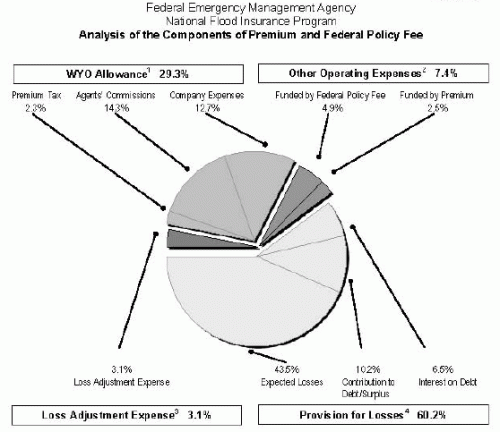I wrote an overview post on the National Flood Insurance Program (NFIP) that is linked below; read that first. While that program is important in its own right, this week I am writing a series of posts considering what the 43 year old history of the NFIP could mean for health policy, with special emphasis on Medicare.
- Overview of National Flood Insurance Program
- NFIP and Health Policy-1: Why were NFIP and Medicare passed?
- NFIP and Health Policy-2: Distribution of risk in NFIP and Medicare
- NFIP and Health Policy-3: Who is responsible for mitigating risk?
This post will focus on the role of the federal government and private insurance companies in the NFIP and the Medicare Advantage program. The NFIP was created in 1968 because flood risk was deemed to be privately uninsurable, and the federal government has borne all of the underwriting risk of flood insurance ever since. However, private insurance companies sell and service policies, including claims adjustment, and they are paid for these efforts. The distribution of premium dollars in the NFIP is shown below (p. 45).
 Around 3 in 10 premium dollars go to private insurance companies for administrative expenses (WYO or Write Your Own policies), including profit, and around 6 in 10 dollars goes to pay for expected annual losses, paying off past losses and pre-paying unusual annual losses. The other 1 in 10 dollars are for other administrative costs incurred by the federal government directly providing flood insurance.
Around 3 in 10 premium dollars go to private insurance companies for administrative expenses (WYO or Write Your Own policies), including profit, and around 6 in 10 dollars goes to pay for expected annual losses, paying off past losses and pre-paying unusual annual losses. The other 1 in 10 dollars are for other administrative costs incurred by the federal government directly providing flood insurance.
The Medicare Advantage Program provides an option whereby beneficiaries can choose private insurance plans in lieu of traditional Medicare as their health insurer. By comparison, the median administrative expenses going to private insurance companies in Medicare advantage plans in 2006 was 8.1% (this number was harder to find that I expected; let me know if you have an alternate source). Several points:
- More of the premium dollar goes to administrative expenses in private company serviced flood insurance (called WYO allowances in figure) ~30% as compared to 8.1% (median) in Medicare Advantage; 30% is twice as high as the 15% to be allowed to not go toward care for private plans sold in exchanges under the ACA. Update: 20% can go to admin for individual policies, 15% for group.
- The federal government holds all the underwriting risk in the NFIP, whereas private insurance companies take on the risk for Medicare Advantage beneficiaries
- Selection effects exist in both programs. In the NFIP, private companies decide what properties they will provided coverage for, with and the federal government directly insuring the remainder; in Medicare Advantage, private companies decide in what geographic areas to offer and market their plans. Both mechanisms likely serve to get the “least sick and at risk” into private plans.
- The benefits offered by Medicare Advantage plans differ, whereas the value of benefits available in the NFIP are capped ($250,000 dwelling loss, $100,000 contents)
- The benefits offered by the NFIP have declined in real terms as the $250,000/$100,000 caps have been in place for some time, while those for Medicare Advantage have risen
- In both programs there is have been policy goals related to premiums that have been hard to achieve. In the NFIP, premiums are expected to cover the expected value of losses, but that has not always happened due to things like annual premium caps, and subsidy of grandfathered properties. In Medicare Advantage, earlier payment rates were set below average with a goal of saving money, which did not occur because healthier persons selected into the plans

